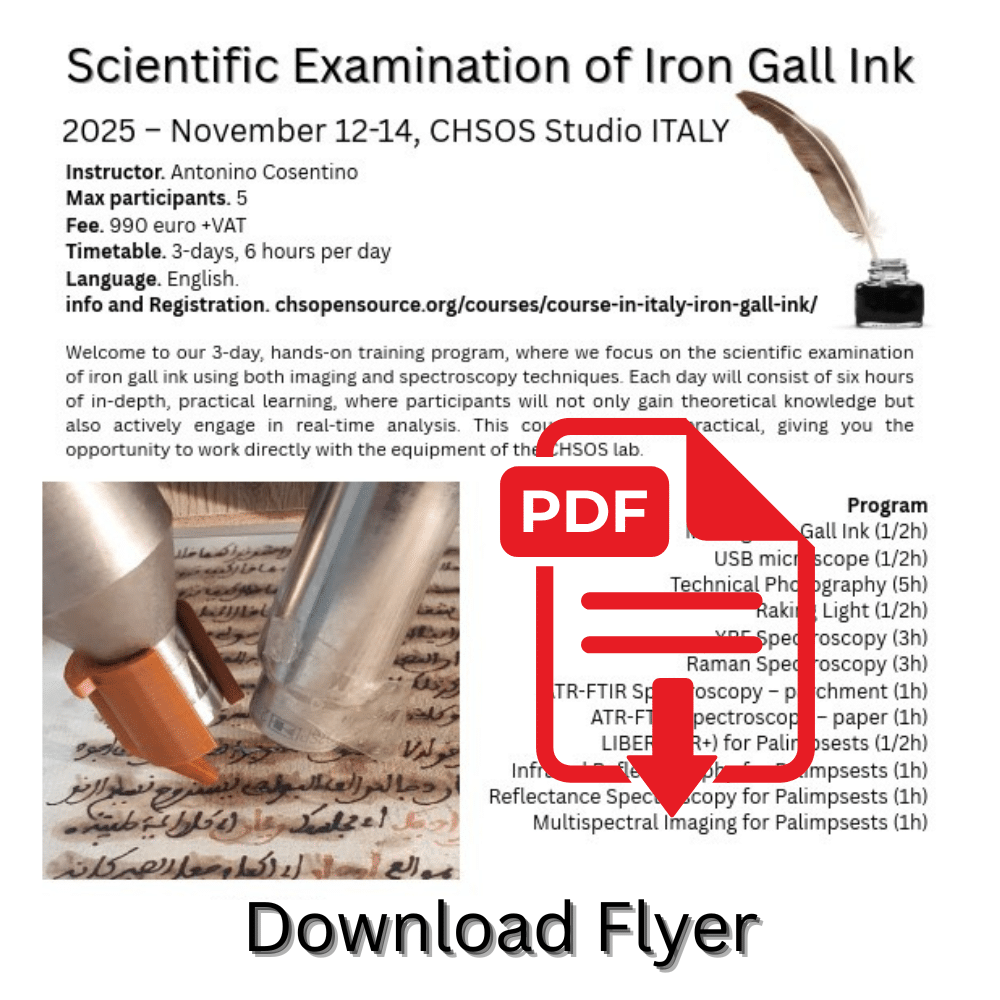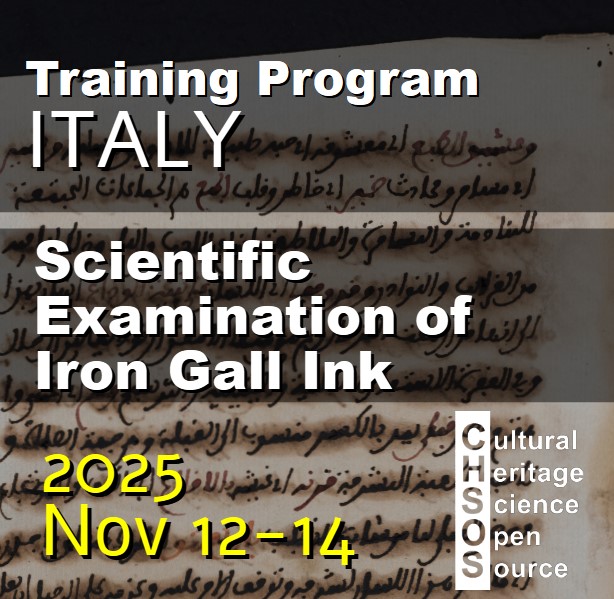IRR is a complementary method to IR photography in order to reveal underdrawing and changes in a work of art. It is done with a specialized and costly scientific camera, generally, an InGaAs camera. A less-known variation of this method is IRRF, Infrared Reflectography Fluorescence. Such as for IRF, Infrared Fluorescence photography, some pigments can be identified by their fluorescence emission in the IRR spectral region (1000-1700 nm). This note discusses the findings of this method tested on our 2 Pigments Checkers, "standard" and "modern & contemporary art". Some case studies are also discussed ranging from easiel paintings, historical prints, and pottery.
Infrared Reflectography (IRR) allows identifying underdrawing and pentimenti. It is performed with a scientific camera that can image in the spectral range of 900- 1700 nm. Pigments such as azurite, Prussian blue, and malachite become transparent only in the far-infrared at about 1500 nm. The imaging sensors of these cameras are small and numerous images are stitched together in order to have a final image with enough resolution.
IRR is a complementary method to IR photography in order to reveal underdrawing and changes in a work of art. A less-known variation of this method is IRRF, Infrared Reflectography Fluorescence. This tool is conceptually similar to the IRF, Infrared Fluorescence, a method that is part of the standard Technical Photography documentation.
IRF allows the detection of Egyptian blue and cadmium-based pigments.
Some molecules and minerals (among them mineral pigments) exhibit Infrared Fluorescence. This phenomenon is similar to Ultraviolet Fluorescence where a beam of ultraviolet light produces visible light emission. In the case of infrared fluorescence, a beam of visible light, or UV radiation, generates an emission of infrared radiation. In this case, we use, respectively the acronyms IRF-VIS or IRF-UV.
IRF photography can be made using the VIS lamp ALICE or the UV lamp FABRIZIO. In this case, we call the methods, respectively, IRF-VIS and IRF-UV, indicating that we are using the standard visible lamp or the UV lamp. The UV lamp is recommended to increase the emission from cadmium pigments while the VIS lamp is fine for Egyptian blue.
IRRF is analogous, but we must use the most costly InGaAs camera in order to explore the fluorescence emission in the far-infrared region 1000-1700 nm.
Pigments Checkers “Standard” and “Modern & Contemporary Art”
We tested the 2 current pigments checkers, “standard” and “Modern & Contemporary Art”. The STANDARD Pigments Checker is a collection of the most used pigments from prehistory to contemporary art, and consequently, it has just few modern pigments. On the other hand, the new one is a collection of the most important pigments used in modern & contemporary art. This checker is focused solely on modern pigments and completes those already included in the standard Pigments Checker. The colors are laid with an acrylic binder on cardboard support.
Lamps for Infrared Reflectography Fluorescence
The fluorescence in the IRR region can be excited with different sources in the spectral ranges at higher energies than IRR: UV, VIS, and IR. The best results were acquired with the VIS-only lamp ALICE.
UV region. We tested 3 UV lamps: 365 nm (UV lamp Fabrizio), 254 nm, and 222 nm. Only the UV lamp Fabrizio was able to generate fluorescence in the IRR spectral range. This method is called IRRF-UV.
VIS region. VIS-only lamp, Alice. This is the source that produced the strongest fluorescence. This method is called IRRF-VIS.
IR region. LEDs lamps at 850 nm, and 950 nm. These did not provide any fluorescence. This method is called IRRF-IR.
Pigments Checker STANDARD
Figure [1] shows the IRRF-UV and IRRF-VIS images (IRRF-IR did not provide any fluorescence) of the 2 Pigments Checkers. The IRRF-VIS provides the same results that we are used to in IRF photography, while IRRF-UV does not produce strong fluorescence from any pigments.

Pigments showing IRRF with the VIS lamp Alice (in descending fluorescence-intensity order):
Egyptian blue
hun blue
cadmium red
This is what we already see in IRF photography, so there isn’t any advantage in using IRRF for this collection of pigments.
Pigments Checker “Modern & Contemporary Art”
Pigments showing IRRF with the UV lamp Fabrizio (in descending fluorescence-intensity order):
PY 53 – nickel titanium yellow
PB 33- manganese blue
cadmium red (TP–MSI calibration card)
PG 36 – phthalo green YS
Pigments showing IRRF with the VIS lamp Alice (in descending fluorescence-intensity order):
PB 33- manganese blue
PY 53 – nickel titanium yellow
cadmium red (TP–MSI calibration card)
PG 36 – phthalo green YS
The IRRF-UV makes the PY 53 – nickel titanium yellow brighter, but the IRRF-VIS is definitely better to increase the fluorescence of one more pigment, PG 36 – phthalo green YS, figure [2].

PB 33 – manganese blue
PB 33 – manganese blue was used from 1935 to the 1990s. It had success both as artist pigment as well as for conservation. Indeed, it was most appreciated in a number of industrial applications. Among famous artists using it, we have Diego Rivera. In conservation, manganese blue is appreciated for painting retouching and, in particular, as an excellent non-metameric match for azurite.
The IRRF of this pigment is known and was investigated in 2014 [1]. This fluorescence emission is centered at about 1300 nm, so it cannot be detected with standard IRF (using a modified photo camera), but we need an InGaAs camera that is able to detect this farther infrared range.
IRRF is used to map this pigment both on modern art paintings as well as a conservation retouching pigment. Since we know pretty well the time it was in use, it can assist in dating the painting or at least its conservation intervention.
PY 53 – nickel titanium yellow
Developed in 1954, this more recent pigment also features strong IRRF emission. So far, we didn’t find any published study on the fluorescence of this pigment. It is commercialized as an artist color and it is considered a safer replacement for Naples yellow.
PG 36 – Phthalo green YS
From 1957, this is the more recent and the less bright of these pigments emitting in the IRRF imaging. It is a bromated and chlorinated copper phthalocyanine. Must be noted that there are other 2 phthalocyanine pigments, in Pigments Checker STANDARD: PB 15 – phthalo blue, and PG 7 – phthalo green. These pigments do not show any IRRF emission.
Case study: Ireland map, 1604
We tested these imaging methods on an Ireland map. ORTELIUS, Abraham. Ausszug auss des abrahami Ortely Theatro Orbis…. Frankfurt, J Keerbergen and L. Hulsius: 1604, figure [3].

The investigation with IRF (both IRF-VIS and IRF-UV ) did not provide any fluorescence emission. We also tested IRRF (VIS and UV). IRRF-VIS reveals a strong fluorescence, figure [3]. In this image, we see the IRRF of the cadmium red swatch in our TP-MSI calibration card which serves as a check that the image was taken correctly. More interesting, we also appreciate that the map’s yellow frame has a strong fluorescence emission. We are working on achieving the actual identification of this material with other analytical techniques. So far, the only yellow pigment that is known for its IRRF emission is the modern PY53 – nickel titanium yellow. Of course, if this is confirmed, at least the coloring would be a fake addition to an original unpainted map.
Case study: Jerusalem map, 1702
We tested a large map of Jerusalem, dated 1702. Edit by Daniel Stoopendaal (35,5 x 46 cm). In excellent condition, split at the bottom, reinforced on the back, and beautifully colored by hand, figure [4]. Verso: Dutch text.
IRF photo did not reveal any fluorescence, on the other hand, IRRF-VIS shows the fluorescence originating from large areas of the map painted light yellow and pale red, figure [5]. Also, these materials would need further analytical investigation for their identification.


Case study: 2 studio paintings, 1970′
This studio painting (60 x 43 cm) dated around the 70′ exhibits strong IRRF emission coming from the yellow pigment and the green areas (which as far as we know could be a mixture of the yellow IRRF emitting pigment), figure [6]. No IRF emission was detected.

The imaging analysis of the second studio painting shows that the red pigment used for the lady’s lips features both IRF and IRRF, strongly suggesting the use of cadmium red, figure [7].

Case study: photograph conservation
A preliminary examination of historical photos suggests that the IRRF method can have practical applications for photograph conservators. Figure [8] shows the IRRF image revealing the fluorescence originating from some of the white areas in a historical photo (CHSOS collection, item #55).

Similar observations can be made on another photo (CHSOS collection, item 59). Figure [9] reveals the IRRF emission in some white tones areas.


Case study: historical prints conservation
As an example of the IRRF possible applications for historical prints, we show the image taken on a historical postcard, figure [10]. There is an IRRF emission coming from the white areas, but not all of them. Indeed, some white spots do not have any IRRF output, indicating, likely the use of different materials, figure [11].


Case study: pottery conservation
Even pigments used for pottery can show IRRF emission. Figure [12] illustrates the case of a porcelain color sample plate. This kind of plate shows the individual pigments and it allows the evaluation of the manufacturer’s range of vitrifiable colors for porcelain. The orange color is bright in the IRRF photo and in the IRF, likely being a cadmium-based orange pigment.

Conclusion
As for IRF, also IRRF can be valuable to map modern pigments on works of art easily. As shown in the case studies, there could be other artists and conservation materials that exhibit IRRF emission than those already documented in the Pigments Checkers. Thus, the need to test more and add them to upcoming charts.
By the way, one advantage of this method is that it can be performed without unframing the painting. VIS (input) and IRR (output) radiations can easily pass through the glass, so there is no need to remove the glass cover from framed canvases.
References
[1] Accorsi, G. et al. “Imaging, photophysical properties and DFT calculations of manganese blue (barium manganate( VI ) sulphate) – a modern pigment” Chem. Commun., 2014,50, 15297.









